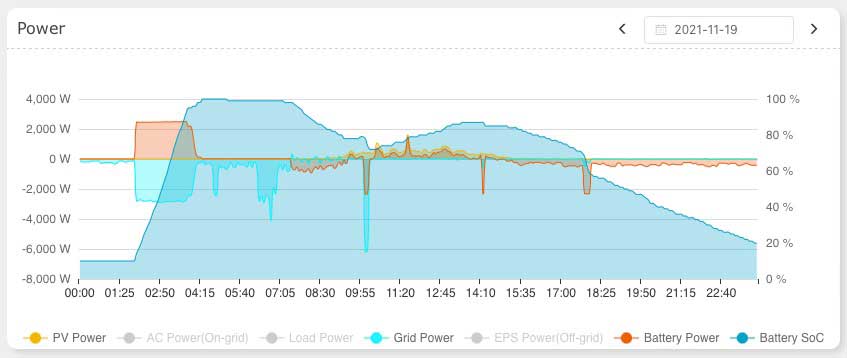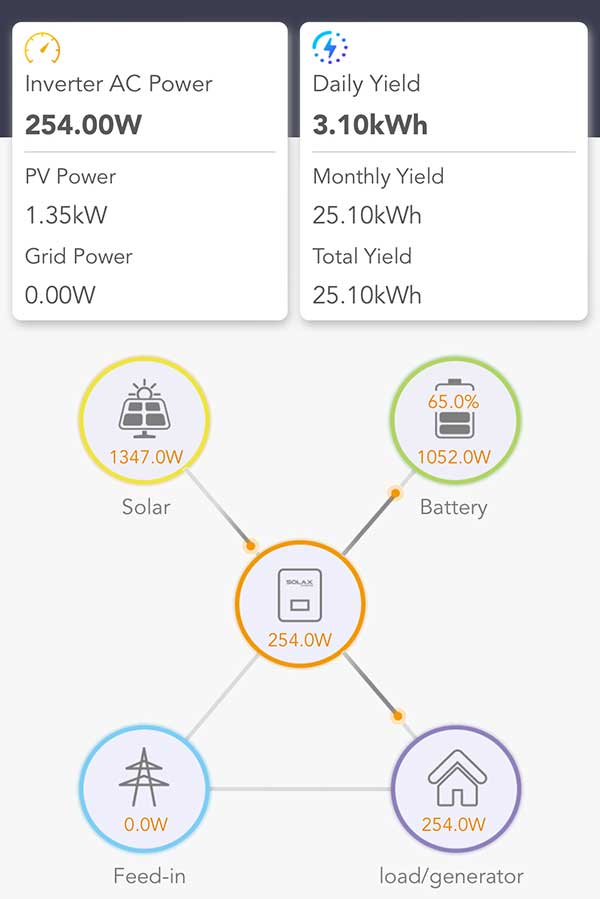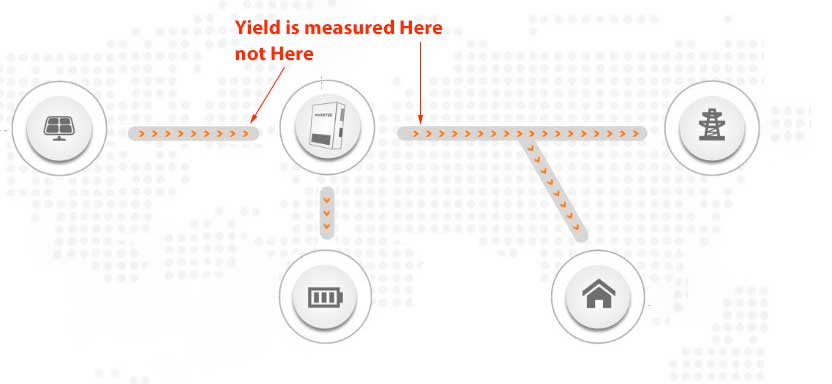Solar Battery Storage and Force Charging
Our new Solax solar system seems to be working well. There were a few teething problems and plenty to configure to get it all working in what we think is the most efficient way, so here’s the deal.
The solar panels started working straight away. Even on cloudy days they were pretty much covering our background electricity usage for a few hours each day. On sunny days they were producing more than we were using so we looked to our battery to store this excess for use later in the day.
Battery Issues
Unfortunately there was an issue with the battery storage that we had installed. It came pre-charged with around 50% of its 5.8kWh capacity. We expected to see some or all of this to be used up initially until the battery was at 10%. We have things set to use Solar energy first if it’s available. If there’s no solar being generated we should use energy stored in the battery and finally energy from the grid.
We then expected that once the sun came out and we were generating more energy from our solar panels than we were using that the battery would recharge.
Unfortunately none of this seemed to happen. The battery didn’t discharge as we expected and the energy in it wasn’t used to power the house. Instead it just slowly discharged over a few days and even dropped below the set minimum of 10% until it was at 0%. It didn’t help that we had a few rainy days so generated very little excess but once we were generating excess it was clear that the battery wasn’t charging either.
Dan & Steve from Pure Electrics were called back out and after some fiddling and some back and forth with Solax a loose connection within the battery was identified and things were up and running. The flow of energy from the solar panels, into the house and battery and out to the grid was finally established and all looked OK.
In the image above you can see that the solar panels are producing 1347 Watts. 254 Watts is being used to supply the demands of the house and the remaining 1052 Watts is being used to charge the battery (which is currently at 65% charge). I know that 1052 + 254 is 1306, not 1347, but the inverter itself needs some power in order to work so some will be used there as well.
Force Charging
We’re on an Economy 7 electricity tariff. We have no gas or oil here so all of our power for everything is from electricity. This includes storage heaters for heating the house. We have cheaper rate electricity for 7 hours overnight and therefore wanted to optimise things to make use of this cheap tariff.
That means ‘force charging’ the battery from the grid during the cheap rate period. We only expect this to be beneficial during the winter months. During this time the sun is lower in the sky and daylight lengths are short so the amount of energy produced by the solar panels will be minimal. It might cover our background use during daylight hours but surplus energy won’t be substantial and if there is any it’ll only be for a short period of time. This surplus will charge the battery a little but not fully. It also gets dark early so anything stored in the battery during the day will be used up in the evening.
This means that if we top the battery up with cheap rate electricity overnight we can use that in the morning rush hour when demands are higher. Essentially extending our cheap rate period by 5.8kWh. I guess it’s similar to what the storage heaters do really. They charge up overnight and then store heat that is released during the day. Our battery too is force-charged overnight and then stores that cheap-rate energy for use during the day. Once the sun is out that energy in the battery is supplemented by solar power and at times the battery re-charges from the solar too. This means that there is some remaining for the evenings once the sun has set.
Perfectly Timed
In fact, the first day that everything was working properly things worked out perfectly. The battery charged overnight and then gradually discharged throughout the day. It was topped up a little from solar around midday and then gradually drained over the evening, hitting 10% at around midnight, just as the cheap rate electricity kicked in again ready to top it back up.

- The large blue shaded area shows the state of charge of the battery.
- The bright blue area shows the amount of power flowing through the inverter, negative is flowing from the grid, positive is energy being exported to the grid (note this doesn’t include the Economy 7 circuit which powers just the storage heaters and immersion heater).
- The red area shows the amount of power flowing to and from the battery, positive when charging, negative when discharging.
- The yellow area shows the amount of energy being produced by the solar panels.
You can see the initial draw from the grid to charge the battery for a few hours overnight. [The early morning draw from the grid that morning was because we didn’t have the battery set to force charge until the end of the Economy 7 period. We have since changed this.] You can then see that from around 7:30am we were using power from the battery. Things such as the showers at around 10am draw more power than the battery and solar panels can manage so there is also a hit on the grid for these peaks. Much of it still comes from the battery though. Other than large demands such as these, our energy demands were met by solar power or battery power right through until midnight. The battery even recharged a little between 10am and 2pm from the solar panels.
Tweaks
We have tweaked things a little now. The battery is now set to Force Charge for the entire Economy 7 cheap period. This means it won’t start discharging until the more expensive day rate is being applied. This maximises our time on the cheap rate electricity and means that we have as much cheap rate electricity stored in the battery as possible too.
It’s likely that we’ll have to change things in the summer. We don’t expect Force Charging to be necessary once the days are longer. It’s likely that there will be more surplus from the solar panels that will easily supply our demands during the day and therefore be stored in the battery. The longer days in the summer will also mean that we’ll be drawing from the battery less in the mornings and evenings too so it’s likely that we’ll be able to power the night-time demands from the solar energy stored in the battery. That should mean there will be no need to force charging overnight. Quite when we’ll turn force charging off remains to be seen. It’s something we’ll have to keep an eye on, or maybe something we’ll just do whenever the clocks change.
Monitoring
Part of the fun is monitoring it all. We have a Solax App and website where we can see what the solar panels, inverter and battery are doing. This doesn’t know anything about the Economy 7 circuit though and doesn’t communicate with the Zappi car charger either. We also have a MyEnergi app that does now know the total demands of the house including the Economy 7 circuit and also knows about the Zappi car charger. It doesn’t however know anything about the inverter, battery or solar panels!
Being a little geeky I started building a WordPress plug-in to display some of the info from these apps on this website. The plug-in tapped into the Solax API to retrieve the data from their server. This was delivered as JSON output which I then inserted into a MySQL database allowing me to present the data as a series of tables and charts within a WordPress web page.
Unfortunately the data that the Solax API returns isn’t quite what I wanted. The Live Power data from solar panels that the API reports is correct and interesting to look at. However, the fact that it only updates once every 5 minutes does make it a little less interesting than it could be. It’s not the end of the world and does reduce the load on the server at that update rate I guess.
The daily, monthly and total yield data isn’t quite what I wanted though. I had hoped it would be, but rather than reporting the daily, monthly and total yield from the solar panels it actually reports the daily, monthly and total ‘yield’ from the inverter. In other words, the current transformer measuring this ‘yield’ is downstream of the inverter rather than being downstream of the panels.
If we didn’t have a battery this would be fine and as it would be the equivalent of the yield from the battery minus any parasitic load from the inverter. However, with a battery attached to the inverter as well, the ‘yield’ that the Solax API reports includes all of the power flowing through it from both the solar panels and the battery. This means that if we force charge the battery overnight from the grid, when that is discharged again it is counted as ‘yield’. Not really what I wanted as it doesn’t tell me how much energy the solar panels have produced.
So far I haven’t found a way around this. I could probably solve it with the addition of some CT clips but I’m not sure how I’d get those integrated with the Solax API The other option would be to add CT clips to the MyEnergi system that the car charger uses and tap into their API instead. But that would require the purchase of a wireless hub for the CT clips and starting all over again with a new API. I think I’ll leave it for now!
Optimisations
Building a WordPress plug-in was just a bit of fun really so if it doesn’t do what I want it to it doesn’t matter. What does matter is that:
- The solar panels are producing clean, free energy- which they are.
- The energy from the solar panels is being used to power the house, charge the car and charge the battery – which it is.
- Free solar energy and cheap-rate grid energy is keeping the battery topped up – which it is
- Energy in the battery is being used by the house when needed – which it is
- We’re maximising our time on cheap-rate electricity and minimising draw from the grid during peak-rate times – which we are
We also want to minimise any export to the grid if possible as we can’t get paid for anything we export. The (FiT) Feed in Tariff for such things no longer exists and we can’t make use of the SEG (Smart Export Guarantee) as we don’t (and apparently can’t) have a smart meter. This means that anything we export to the grid is given back to the power companies for free – we don’t want to do too much of that if we can help it! It will be difficult to avoid this in the summer but we do have the Electric Car so that can be used as a second, much larger battery into which we can feed any surplus before it goes to the grid.

















Glad you’re having fun playing around with numbers lol
Most people would just hope for the best that it’s working as it should be! Before long you’ll have people asking you all about it and the best ways to set up etc just like your garmin .
Hopefully it will save you money in the long run as well as giving you something to ” play around with”
I think I’ve ironed out most of the issues in the plug-in I was building to display stats from our solar panels.
I’ll write more about it later in a blog post. But, I’ve addressed the issue caused by fact that the ‘yield’ is measured downstream of the inverter. This means that the ‘yield’ value includes any energy taken from the battery as well as that coming from the solar panels. I want to display just that from the panels. I decided that in the absence of a measurement of this value, I could calculate a close enough approximation.
This will only be an issue when force charging from the grid overnight because this means that some of the energy coming out of the battery will be from the grid, not the solar panels. So, the plug-in now checks to see if the battery is being force charged. If it is, the amount of energy put into the battery by force charging is calculated and it is assumed that as the battery drains it is this energy that is discharged first. So, any power discharged in this manner is deducted from the ‘yield’ so as to give just the yield from the panels.
It’s not perfect and I might tweak the algorithm somewhat over the next few days but it seems pretty accurate so far.
You can see the basics of the solar monitoring page here: https://www.alananna.co.uk/blog/solar-generation/
Al.
Hi there can you tell me how to discharge the ull battery into the grid at 3 to 7 pm im with solax and octopus go kind regards william
Hi William,
I don’t think that’s possible with a Solax Inverter at the momnent, (or many other inverters for that matter). There wouldn’tbe many occasions where doing so would make economic sense as it’s usually better to keep the energy stored in the battery and then use it when your needs are greater than the amount you are generating and electricity prices are high.
Al.
Hi Alan, it sounds like you have a similar PV system to me and I was wondering how to set up the Solax battery and Inverter to do the same “force charge” in the middle of the night and utilise my Octopus Flux tariff? Was this just a user setting you put in yourself or did you have to call in a specialist? What’s the trick?
Hi Graeme, I’ve got some instructions here: https://www.alananna.co.uk/blog/2022/06/force-charging-with-a-solax-inverter-and-battery/
Does that help?
Alan.
Thanks Alan. I’ve found most of the functions in v4.2.8 of the Solax Cloud ipad app. I’ll have a little pay around with the settings and see what I can set up.
Solar integration with EV charging is a brilliant idea for sustainability. This blog post offers a personal perspective on combining solar energy and EV charging. The real-world experience shared here is valuable for those considering a similar setup. It’s an inspiring read for eco-conscious individuals.
Hi Alan, great write up. I was wondering if you have found a way to charge your ev at night without draining the house battery. Some people have mentioned putting the battery to force charge to say 1%(even though battery is at say 90% capacity) doing this tricks the system to think its force charging the battery and therefore won’t discharge to ev, or home appliances during the force charge period. I don’t have my ev yet but very interested in how I can ensure I don’t drain my home battery into the car if I have to boost charge( I have a zappi v2.1 charger)
In our set up, the Zappi doesn’t take from the battery. It’s the other side of the consumer unit and therefore only sees surplus electricity from the panels/battery that is being sent back to the grid – it mips that up but when force charging doesn’t know the battery is there so only ever takes from the grid.